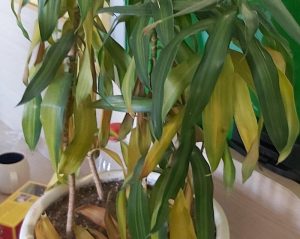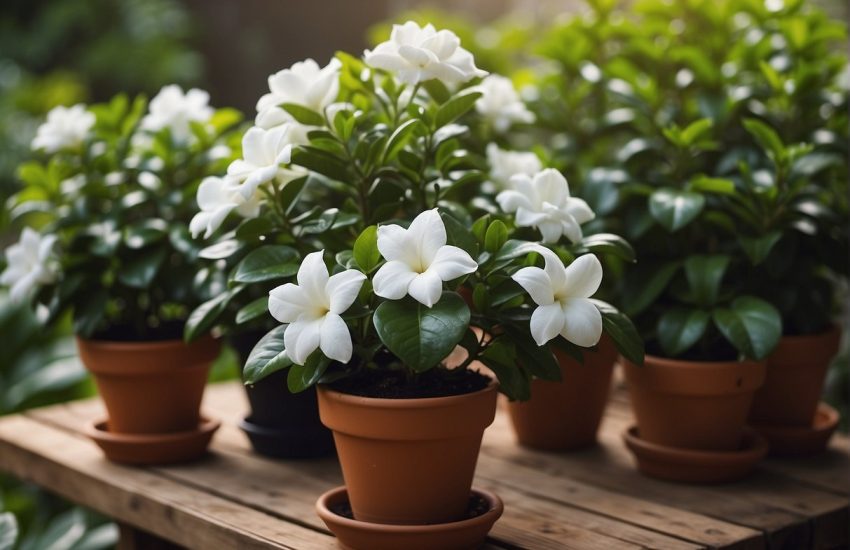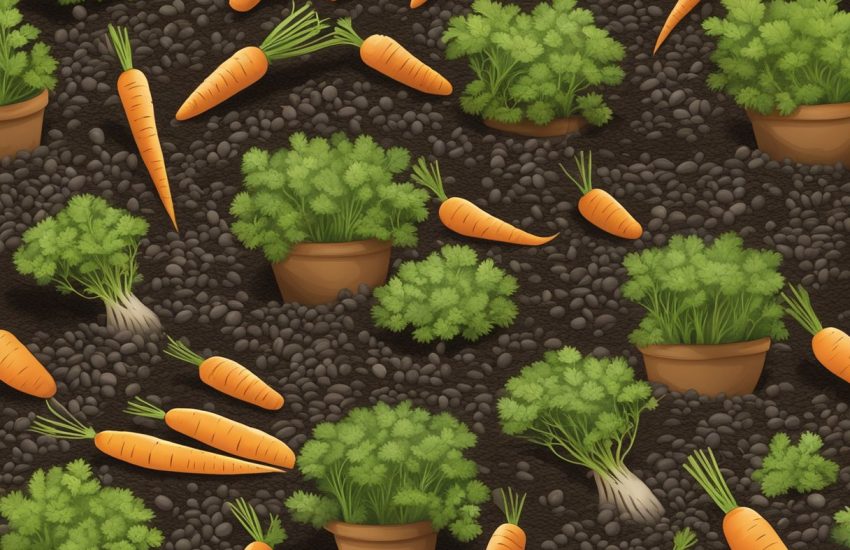Dracaena Leaves Turning Yellow – Reasons and Prevention
If your dracaena leaves are turning yellow, you may be wondering what is causing this and how you can fix it. There are several possible causes for this problem, and fortunately, there are also several solutions. We will discuss the most common causes of yellow leaves on dracaena plants and how to solve them.

1. Overwatering
One of the most common reasons for dracaena leaves to turn yellow is overwatering. When a plant is overwatered, the roots are unable to get the oxygen they need and begin to suffocate. This can cause the leaves to turn yellow and eventually drop off. If you think you are overwatering your plant, To prevent overwatering, water your dracaena plant only when the top inch of soil is dry. According to the University of Minnesota Extension, “ watering once a week should be sufficient.” If you believe your plant is already overwatered, try to save it by carefully removing it from the pot and examining the roots. If they are mushy or have started to rot, you will need to trim them off. The plant can then be replanted in a fresh, dry potting mix.
2. Poor Water Quality
Another possible cause of yellow leaves on dracaena is poor water quality. If the water you are using to water your plant is high in chlorine or other chemicals, it can cause the leaves to turn yellow. To solve this problem, you can either use filtered or distilled water for your plant. According to the National Dracaena Association, “It’s best to let your tap water sit for 24 hours before using it to allow the chlorine to dissipate.”This can also be solved by allowing your plant to sit in a sink full of water for about 30 minutes, so the chlorine can evaporate. If you think poor water quality may be the cause of your dracaena’s yellow leaves, try using filtered or distilled water and see if the problem improves.
3. Cold, Soggy Potting Mix
If the potting mix you are using for your dracaena is too cold or soggy, it can also cause the leaves to turn yellow. This can also be caused by water that is too cold, so make sure you are using room-temperature water for your plant. This can be prevented by using a well-draining potting mix and making sure the pot is not sitting in water. Additionally, you can try using a heating pad set on low to help warm the roots of your plant.
4. Fertilizer Burn
If you are using too much fertilizer, it can cause the leaves to turn yellow from “fertilizer burn.” This is because the fertilizer is burning the roots of the plant. To prevent this, only fertilize your dracaena plant every two months and use half the amount of fertilizer that is recommended. This has the potential to permanently damage your plant, so it is important to be careful. This can lead to the leaves turning yellow and eventually dropping off. If you think your plant has fertilizer burn, try removing it from the pot and examining the roots. If they are black or burned, you will need to trim them off.
5. Temperature Changes
If the temperature around your dracaena plant changes too much, it can also cause the leaves to turn yellow. Dracaena plants like consistent temperatures and do not do well with sudden changes. To prevent this, avoid placing your plant near drafts or heaters. According to the University of Missouri Extension, “Ideal temperatures for dracaenas are between 60 and 70 degrees Fahrenheit.”
6. Pest Infestation
Another possible cause of yellow leaves on dracaena is a pest infestation. If your plant is being eaten by insects, it can cause the leaves to turn yellow and eventually die. To prevent this, inspect your plant regularly for pests and treat it with an insecticide if necessary. Additionally, you can try to prevent pests by keeping your plant clean and dust-free. However, if your plant is already infested, you will need to treat it with an insecticide.
7. Dry Air
If the air around your dracaena plant is too dry, it can cause the leaves to turn yellow. To prevent this, keep the humidity around your plant high by using a humidifier or placing it on a pebble tray. According to the University of Florida IFAS Extension, “Ideal relative humidity for dracaenas is 50% or higher.”This can be increased by using a humidifier or placing the plant on a pebble tray.
8. Older Leaves Turn Yellow Naturally
As dracaena plants age, the older leaves will turn yellow and eventually die. This is completely natural and nothing to be concerned about. To prevent this, simply remove the yellow leaves as they appear and compost them. However, if all of the leaves on your plant are turning yellow, it is not due to this and you should check for other causes.
9. Diseases
Several diseases can cause the leaves of dracaena plants to turn yellow. These include root rot, stem rot, and leaf spot. To prevent these diseases, it is important to water your plant properly and avoid over-fertilizing it. Additionally, you should make sure the pot has drainage holes and is not sitting in water. If your plant is already infected, you will need to treat it with a fungicide.
10. Lack of Light
If your dracaena plant is not getting enough light, it can cause the leaves to turn yellow. Dracaenas need bright, indirect light to thrive. To prevent this, place your plant in a location where it will get plenty of light. However, make sure that the light is indirect and not direct, as this can burn the leaves. If your plant is not getting enough light, you may need to move it to a brighter location.
11. Too Much Light
On the other hand, if your plant is getting too much light, it can also cause the leaves to turn yellow. To prevent this, make sure that the plant is in a location where it will get indirect light and not direct sun. If your plant is getting too much light, you may need to move it to a shadier location. According to the University of Florida IFAS Extension, “Dracaenas will tolerate low light conditions, but they will grow slowly.”
12. Chemical Reactions
If you use any type of chemicals near your dracaena plant, it can cause the leaves to turn yellow. This includes cleaners, pesticides, and even some types of paint. To prevent this, make sure that you keep all chemicals away from your plant. Additionally, be sure to wash your hands after using any type of chemical, as this can transfer the chemicals to the plant.
13. Underwatering
If you do not water your dracaena plant enough, it can cause the leaves to turn yellow. The leaves will first start to wilt and then turn yellow. To prevent this, make sure that you water your plant when the soil is dry to the touch. Additionally, you should fertilize your plant every two weeks during the growing season. If your plant is already wilting, you will need to water it immediately.
14. Salt Buildup
If there is a salt buildup in the soil around your dracaena plant, it can cause the leaves to turn yellow. This is usually caused by using water that is high in sodium or by over-fertilizing the plant. To prevent this, flush the soil with clean water every few months. Additionally, you should use filtered or distilled water to water your plant. If the salt buildup is severe, you may need to report your plant.
15. Flecking
Flecking is a condition that causes yellow spots on the leaves of dracaena plants. It is usually caused by over-fertilization, but it can also be caused by pests or diseases. To prevent this, make sure that you fertilize your plant every two weeks during the growing season. Additionally, you should check your plant for pests and diseases regularly. If your plant is already affected, you can remove the affected leaves.
Dracaena plants can be planted in pots or on the ground. If you are planting your dracaena in a pot, make sure that the pot has drainage holes. It is also important to choose the right type of soil for your plant. Dracaenas prefer well-drained, sandy soils. They can also tolerate a wide range of pH levels, from acidic to alkaline. It is important to water your dracaena plant regularly. However, you should avoid overwatering, as this can lead to root rot. Dracaenas are drought-tolerant plants and can survive long periods without water. However, they will not thrive in these conditions.
To water your dracaena plant, use lukewarm water and soak the soil until it is moist. Be sure to allow the soil to dry out between watering. Dracaenas should be fertilized every two weeks during the growing season. You can use a general-purpose fertilizer or a fertilizer specifically for dracaenas. Dracaenas are relatively low-maintenance plants. However, there are a few things you can do to keep your plant healthy and prevent problems. First, make sure that you choose the right location for your plant. Second, water and fertilize your plant regularly. Third, check your plant for pests and diseases regularly. Finally, remove any affected leaves.
Dracaena plants are relatively easy to care for. There are many different reasons why the leaves may turn yellow. However, most of these problems can be easily fixed with some simple changes to your plant care routine. According to studies, the Dracaena plant is known to remove toxins from the air. These include formaldehyde, benzene, and trichloroethylene. Additionally, they can help to improve indoor air quality.


